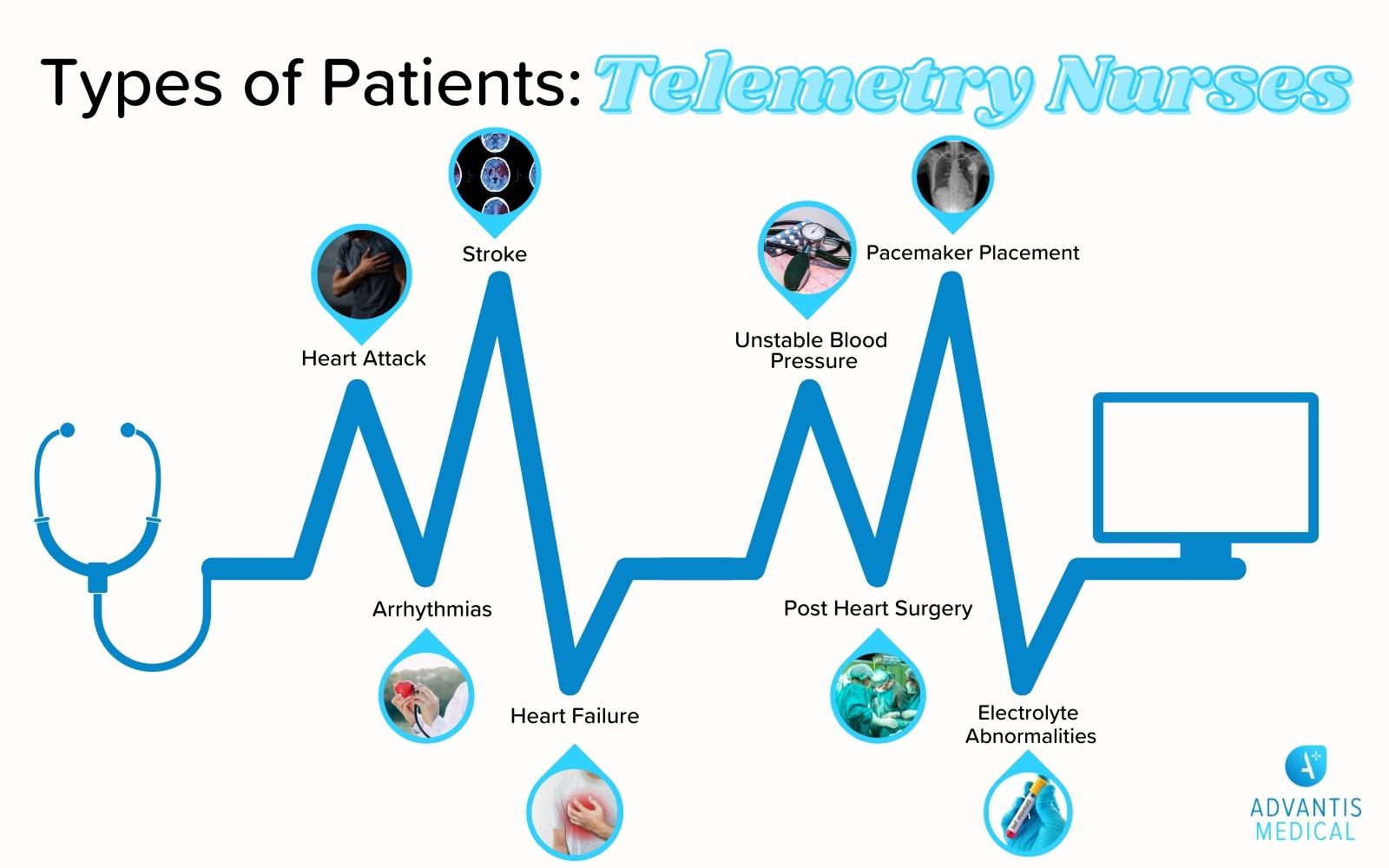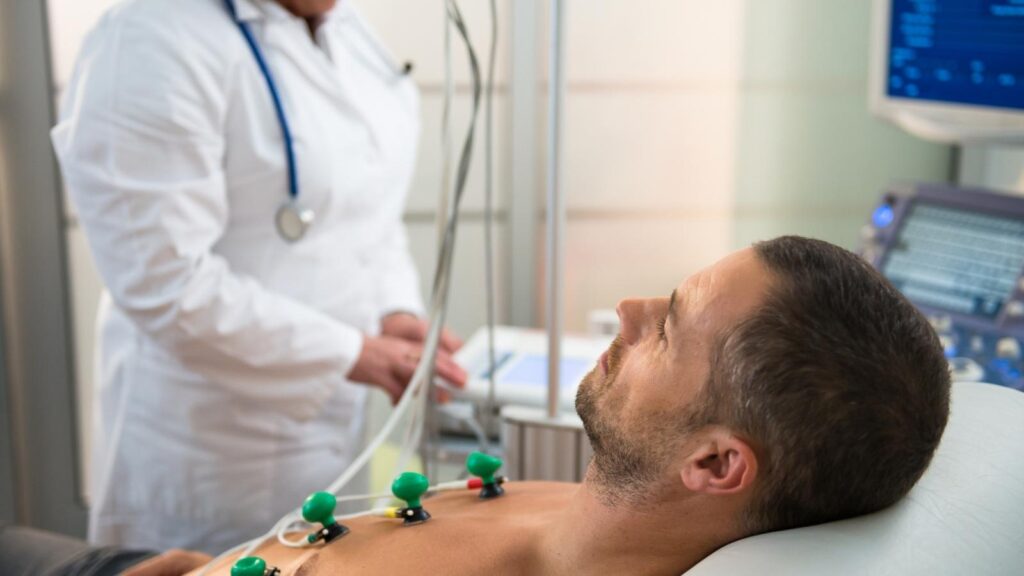Telemetry allows for the continuous monitoring of a patient’s cardiac status and vital signs without invasive equipment. Telemetry boxes are portable and attach to the patient via leads and sticky electrode pads connected to their chest. Information is then sent electronically to centralized monitors. Telemetry nurses are experts in interpreting EKG rhythms and managing all aspects of cardiac care, but their responsibilities only start there.
If you’re intrigued by this vital role and love to travel, then our range of telemetry Travel Nursing Jobs could be just the opportunity for you. Check them out and let your next nursing adventure begin!
The Telemetry Unit
Walking off the elevator onto the telemetry unit you will be greeted by the subtle “beeps of the telemetry monitors. Telemetry units may look the same as other hospital floors except for the rows of monitors that line the walls or sit at the nurse’s station. These monitors provide 24-hour monitoring of the patient’s heart rate and rhythms. When an abnormal rhythm appears, an alarm will sound to alert the nurse.
Most telemetry units have dedicated monitoring technicians located in a centralized location whose role is to do nothing but watch the telemetry monitors. Telemetry nurses are very busy providing all the usual nursing tasks to patients and cannot catch every abnormality. The nurse will often be in a patient’s room administering medications or providing a bed bath when their unit phone will ring. “Room 404 is off their telemetry or “Room 410’s heart rate is 130 are common calls. More often than not, the patient’s leads have fallen off or their heart rate is elevated due to movement. Regardless, assessment of the patient and not the monitor is always required.
The Difference in Telemetry Nursing vs. Other Specialties
Telemetry boxes are about the size of a brick (though not as heavy) and usually fit into the pocket of the patient’s gown. This allows the patient to be mobile and complete ADLs (Activities of Daily Living) while continuing to be monitored. This differs from ICU units where patients are connected to monitors located directly in their rooms.
Telemetry patients are often alert and oriented as well as ambulatory, though this depends on the age and health of each patient. Generally, telemetry patients are more stable than critical care patients.
Types of Patients Treated

Patients treated on telemetry units usually have a presenting diagnosis or history of a cardiac condition. Common conditions include:
- Heart attacks
- Stroke
- Unstable blood pressure
- Arrhythmias such as atrial fibrillation
- Post cardiac bypass or other surgery
- Heart failure
- Pacemaker placement
- Electrolyte abnormalities
Telemetry Nurse Duties
Telemetry nurses perform many of the same tasks as med/surg nurses and truthfully, will often receive med/surg patients when those units are full. The ratio of patients may be slightly less than med/surg (usually 5 patients per nurse) as telemetry patients often require more frequent monitoring.
Policies vary by facility, but telemetry nurses are usually required to read the EKG rhythms of their patients either before starting their shift, at the end of the shift, or both. The rhythm is a random segment throughout the shift that the nurse interprets and signs off on. If the patient experienced an arrhythmia during the shift, this will also be acknowledged by the nurse. Being able to interpret an EKG is a necessary skill of a telemetry nurse. It isn’t an easy skill to master, but with time and practice, you’ll be recognizing heart blocks in no time.
Telemetry nurses partake in skills requiring critical thinking and expert assessment. One example is the administration of cardiac medications and titration of drips. Many high-risk IV drips are only safe for intensive care units, but telemetry nurses also administer medications that affect the blood pressure and heart rate and rhythm requiring close monitoring.
Additionally, telemetry nurses care for patients before and after cardiac procedures such as monitoring for bleeding following cardiac catheterization. Some facilities may perform bedside procedures in which the nurse will assist. Inserting chest tubes, central lines, and cardioversion are often performed by a physician in the patient’s room with the nurse assisting and continuing to monitor for any complications afterward.
Telemetry Certifications
Some telemetry nurses are also stroke certified. Unstable stroke patients will likely be admitted to neuro units or progressive care units but may transfer to telemetry units once stabilized. The National Institutes of Health Stroke Scale (NIHSS) certification is an assessment used to monitor the improvement or deterioration of stroke deficits.
Telemetry units are fast-paced and busy despite the complex nature of patients treated there. This requires telemetry nurses to have experience recognizing subtle changes in vital signs, effects of medications administered, and when to intervene when complications arise. The responsibilities of a telemetry nurse may start with the heart, but they certainly don’t end there!
A Travel Nurse Agency That Truly Cares
We take great pride in supporting travel nurses with more than just top travel nursing jobs—we’re building trusted, long-term partnerships that make your journey smoother, more rewarding, and stress-free. With over 700 5-star reviews and dozens of real nurse testimonials sharing their experiences, we’ve earned our reputation as the #1 travel nurse agency.
Our Advantis Gold Standard ensures you receive personalized support, exclusive travel job opportunities, and a level of care designed to put you first. Whether you want one-on-one guidance from a Pro Recruiter or prefer to explore travel jobs on your own, we’re here to make it easy. Start your next adventure today—explore high-paying travel nurse jobs and discover what’s possible!









